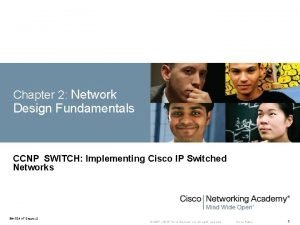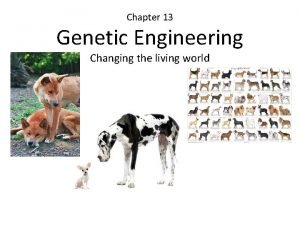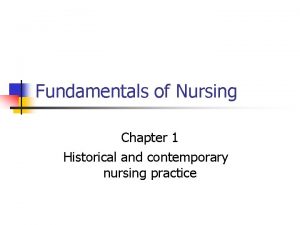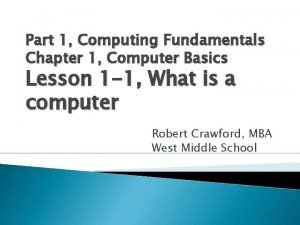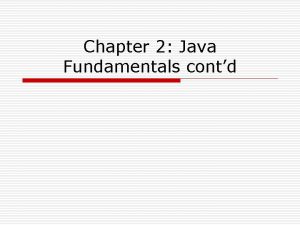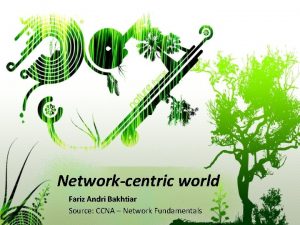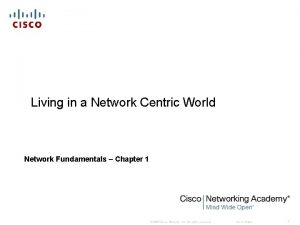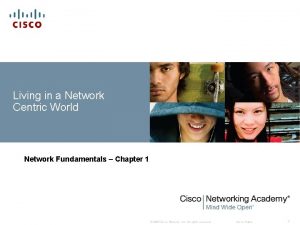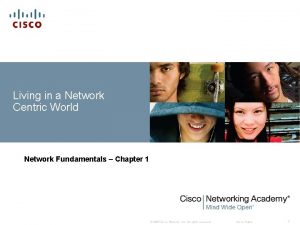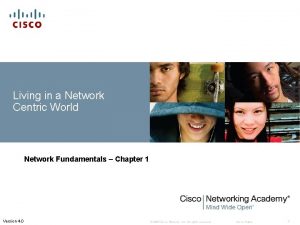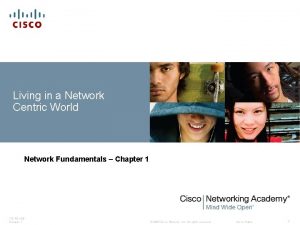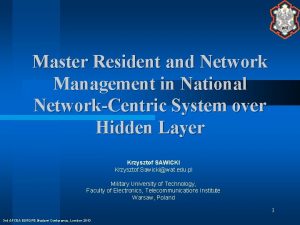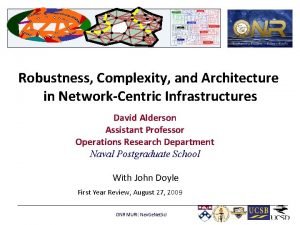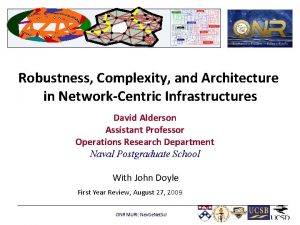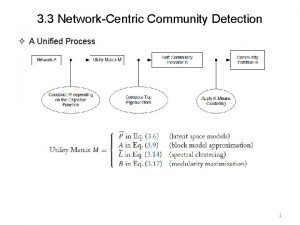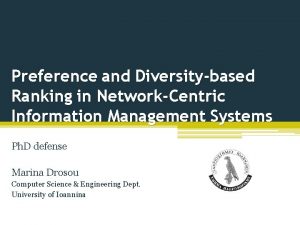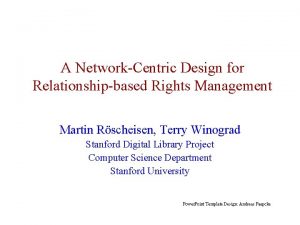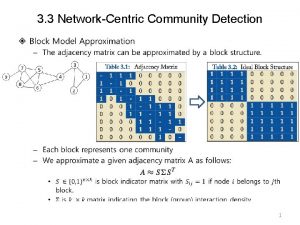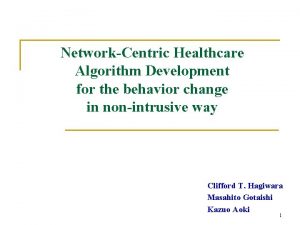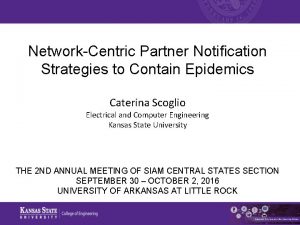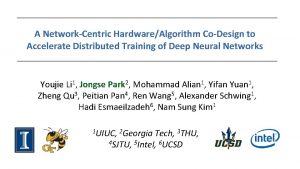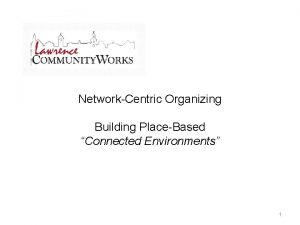Living in a NetworkCentric World Network Fundamentals Chapter












































- Slides: 44

Living in a Network-Centric World Network Fundamentals – Chapter 1 Modified by Tony Chen 05/20/2008 ITE I Chapter 6 © 2006 Cisco Systems, Inc. All rights reserved. Cisco Public 1

Notes: § If you see any mistake on my Power. Point slides or if you have any questions about the materials, please feel free to email me at chento@cod. edu. Thanks! Tony Chen College of Du. Page Cisco Networking Academy ITE 1 Chapter 6 © 2006 Cisco Systems, Inc. All rights reserved. Cisco Public 2

Objectives § In this chapter, you will learn to: – Describe how networks impact our daily lives. – Describe the role of data networking in the human network. – Identify the key components of any data network. – Identify the opportunities and challenges posed by converged networks. – Describe the characteristics of network architectures: fault tolerance, scalability, quality of service and security. – Install and use IRC clients and a Wiki server. ITE 1 Chapter 6 © 2006 Cisco Systems, Inc. All rights reserved. Cisco Public 3

Networks supporting the way we live § Among all of the essentials for human existence, the need to interact with others ranks just below our need to sustain life. –Communication is almost as important to us as our reliance on air, water, food, and shelter. § The methods that we use to share ideas and information are constantly changing and evolving. –Whereas the human network was once limited to faceto-face conversations. –Early data networks were limited to exchanging character-based information between connected computer systems. –Current networks have evolved to carry voice, video streams, text, and graphics between many different types of devices. ITE 1 Chapter 6 © 2006 Cisco Systems, Inc. All rights reserved. Cisco Public 4

The Global Community § Technology is perhaps the most significant change agent in the world today, as it helps to create a world in which national borders, geographic distances, and physical limitations become less relevant, and present everdiminishing obstacles. –The creation of online communities for the exchange of ideas and information has the potential to increase productivity opportunities across the globe. –As the Internet connects people and promotes unfettered communication, it presents the platform on which to run businesses, to address emergencies, to inform individuals, and to support education, science, and government. ITE 1 Chapter 6 © 2006 Cisco Systems, Inc. All rights reserved. Cisco Public 5

The way we live is supported by services derived by the data network § It is incredible how quickly the Internet became an integral part of our daily routines. § In the course of a day, resources available through the Internet can help you: –Decide what to wear using online current weather conditions. –Find the least congested route to your destination, displaying weather and traffic video from webcams. –Check your bank balance and pay bills electronically. –Receive and send e-mail, or make an Internet phone call, at an Internet cafe over lunch. –Obtain health information and nutritional advice from experts all over the world, and post to a forum to share related health or treatment information. –Download new recipes and cooking techniques to create a spectacular dinner. –Post and share your photographs, home videos, and experiences with friends or with the world. ITE 1 Chapter 6 © 2006 Cisco Systems, Inc. All rights reserved. Cisco Public 6

Popular Communication Tools § Instant Messaging –Instant messaging (IM) is a form of real-time communication between two or more people based on typed text. • The text is conveyed via computers connected over either a private internal network or over a public network, such as the Internet. § Weblogs (blogs) –Weblogs are web pages that are easy to update and edit. • Weblogs give anyone a means to communicate their thoughts to a global audience without technical knowledge of web design. § Wikis –Wikis are web pages that groups of people can edit and view together. Whereas a blog is more of an personal journal. • There is a public wiki, called Wikipedia, that is becoming a comprehensive online encyclopedia. • Private organizations and individuals can also build their own wikis to capture collected knowledge on a particular subject. § Podcasting –Podcasting is an audio-based medium that originally enabled people to record audio and convert it for use with i. Pods. • The audio file is placed on a website where others can download it and play the recording on their computers, laptops, and i. Pods. § Collaboration Tools –Collaboration tools give people the opportunity to work together on shared documents. Without the constraints of location or time zone, individuals connected to a shared system can speak to each other, share text and graphics, and edit documents together. • The broad of data networks means that people in remote locations can contribute on an equal basis with people at the large population centers. ITE 1 Chapter 6 © 2006 Cisco Systems, Inc. All rights reserved. Cisco Public 7

Networks Supporting the way we learn § Courses delivered using network or Internet resources are often called online learning experiences, or e-learning. 1. Traditional learning methods: Provide primarily two sources of expertise: the textbook and the instructor. • These two sources are limited, both in the format and the timing of the presentation. 2. Online courses: Contain voice, data, and video, and are available to the students at any time from any place. • Students can follow links to different references and to subject experts in order to enhance their learning experience. • Online discussion groups and message boards enable a student to collaborate with the instructor, with other students in the class, or even with students across the world. 3. Blended courses can combine instructor-led classes with online courseware to provide the best of both delivery methods. • Access to high quality instruction is no longer restricted to students living in proximity to where that instruction is being delivered. • Online distance learning has removed geographic barriers and improved student opportunity. ITE 1 Chapter 6 © 2006 Cisco Systems, Inc. All rights reserved. Cisco Public 8

Networks Supporting the way we learn § The Cisco Networking Academy Program, is an example of a global online learning experience. –The instructor provides a syllabus and establishes a preliminary schedule for completing the course content. –The Academy program provides text, graphics, animations, and a simulated networking environment tool called Packet Tracer. • Packet Tracer provides a way to build virtual representations of networks and emulate many of the functions of networking devices. –Students may communicate with the instructor and fellow students using online tools, like e-mail, bulletin/discussion boards, chat rooms, and instant messaging. ITE 1 Chapter 6 © 2006 Cisco Systems, Inc. All rights reserved. Cisco Public 9

Networks Supporting the way we learn § In the business world, the use of networks to provide efficient and cost-effective employee training is increasing in acceptance. –Online learning opportunities can decrease timeconsuming and costly travel yet still ensure that all employees are adequately trained to perform their jobs. § The benefits of online courseware are: –Current and accurate training materials. • Courseware is up-to-date. When errors in materials are found and corrected, the new courseware is immediately available to all employees. –Availability of training to a wide audience. • Employees can be given deadlines by which training is to be completed and the employees can access the courseware when it is convenient. –Consistent quality of instruction. • The quality of the instruction does not vary. The online curriculum provides a consistent core of instruction to which instructors can additional expertise. –Cost reduction. • In addition to reducing the cost of travel and the lost time associated with travel, there are other cost reducing factors for business related to online training. It is usually less expensive to revise and update online courseware than it is to update paper-based material. ITE 1 Chapter 6 © 2006 Cisco Systems, Inc. All rights reserved. Cisco Public 10

Networks Supporting the way we work § Initially, data networks were used by businesses to internally record and manage financial information, customer information, and employee payroll systems. § Today, networks provide a greater integration between related functions and organizations than was possible in the past. –Intranets: private networks in use by just one company, enable businesses to communicate and perform transactions among global employee and branch locations. –extranets, or extended internetworks: to provide suppliers, vendors, and customers limited access to corporate data to check order status, inventory, and parts lists. ITE 1 Chapter 6 © 2006 Cisco Systems, Inc. All rights reserved. Cisco Public 11

Networks Supporting the way we work § Consider these business scenarios. –Remote workers, called teleworkers or telecommuters, use secure remote access services from home or while traveling. • The data network enables them to work as if they were on-site, with access to all the network-based tools normally available for their jobs. –Virtual meetings and conferences can be convened which include people in remote locations. • The network provides audio and video capability so all participants can both see and hear each other. • The information from the meetings can be recorded to a wiki or blog. The latest versions of the agenda and minutes can be shared as soon as they are created. ITE 1 Chapter 6 © 2006 Cisco Systems, Inc. All rights reserved. Cisco Public 12

Networks Supporting the way we play § The widespread adoption of the Internet by the entertainment and travel industries enhances the ability to enjoy and share many forms of recreation, regardless of location. –It is possible to explore places interactively that previously we could only dream of visiting, as well as preview the actual destinations before making a trip. § The Internet is used for traditional forms of entertainment, as well. We listen to recording artists, preview or view motion pictures, read entire books and download material for future offline access. –Live sporting events and concerts can be experienced as they are happening, or recorded and viewed on demand. § Networks enable the creation of new forms of entertainment, such as online games. –We compete with friends and foes around the world in the same manner if they were in the same room. § Online markets and auction sites provide the opportunity to buy, sell and trade all types of merchandise. § Whatever form of recreation we enjoy in the human network, networks are improving our experience. ITE 1 Chapter 6 © 2006 Cisco Systems, Inc. All rights reserved. Cisco Public 13

What is communication? § Communication in our daily lives takes many forms and occurs in many environments. § Establishing the Rules § Before beginning to communicate with each other, we establish rules (protocols) or agreements to govern the conversation. Among the protocols that govern successful human communication are: –An identified sender and receiver –Agreed upon method of communicating (face-to-face, telephone, letter, photograph) –Common language and grammar –Speed and timing of delivery –Confirmation or acknowledgement requirements § The techniques that are used in network communications share these fundamentals with human conversations. –In establishing data networks, it is necessary to be much more explicit about how communication takes place and how it is judged successful. ITE 1 Chapter 6 © 2006 Cisco Systems, Inc. All rights reserved. Cisco Public 14

Quality of communications § Communication between individuals is determined to be successful –when the meaning of the message understood by the recipient matches the meaning intended by the sender. § However, as a message moves through the network, many factors can prevent the message from reaching the recipient or distort its intended meaning. These factors can be either external or internal. –External Factors • The quality of the pathway between the sender and the recipient • The number of times the message has to change form • The number of times the message has to be redirected or readdressed • The number of other messages being transmitted simultaneously on the communication network • The amount of time allotted for successful communication ITE 1 Chapter 6 © 2006 Cisco Systems, Inc. All rights reserved. Cisco Public 15

Quality of communications: Internal Factors § Internal Factors –Internal factors that interfere with network communication are related to the nature of the message itself. § Internal factors affecting the successful communication across the network include: –The size of the message • Large messages may be interrupted or delayed at different points within the network. –The complexity of the message –The importance of the message • A message with a low importance or priority could be dropped if the network becomes overloaded. § Both the internal and external factors that affect the receipt of a message must be anticipated and controlled for network communications to be successful. –New innovations in network hardware and software being implemented to ensure the quality and reliability of network communications. ITE 1 Chapter 6 © 2006 Cisco Systems, Inc. All rights reserved. Cisco Public 16

Quality of communications: Internal Factors § Demo: PING test ITE 1 Chapter 6 © 2006 Cisco Systems, Inc. All rights reserved. Cisco Public 17

Communicating over networks § In order to support the immediate delivery of the millions of messages being exchanged between people all over the world, we rely on a web of interconnected networks. All networks have four basic elements in common: –Rules or agreements to govern how the messages are sent, directed, received and interpreted –The messages or units of information that travel from one device to another –A means of interconnecting these devices - a medium that can transport the messages from one device to another –Devices on the network that exchange messages with each other § The standardization of the various elements of the network enables equipment and devices created by different companies to work together. –Experts in various technologies can contribute their ideas on how to develop an efficient network, without regard to the brand or manufacturer of the equipment. ITE 1 Chapter 6 © 2006 Cisco Systems, Inc. All rights reserved. Cisco Public 18

Elements of a network § The diagram shows elements of a typical network, including –devices, –media, –rules, –messages. • We use the word messages as a term that encompasses web pages, e-mail, instant messages, telephone calls, and other forms of communication enabled by the Internet. § In this course, we will learn about a variety of messages, devices, media, and services that allow the communication of those messages. –We will also learn about the rules, or protocols, that tie these network elements together. ITE 1 Chapter 6 © 2006 Cisco Systems, Inc. All rights reserved. Cisco Public 19

Elements of a network § Icons are commonly used to represent networking devices. § On the left side of the diagram are shown some common devices which often originate messages that comprise our communication. –These include various types of computers (a PC and laptop icon are shown), servers, and IP phones. On local area networks these devices are typically connected by LAN media (wired or wireless). § The right side of the figure shows some of the most common intermediate devices, used to direct and manage messages across the network. –Switch - the most common device for interconnecting local area networks –Firewall - provides security to networks –Router - helps direct messages as they travel across a network –Wireless Router - a specific type of router often found in home networks –Cloud - used to summarize a group of networking devices, the details of which may be unimportant to the discussion at hand –Serial Link - one form of WAN interconnection, represented by the lightning bolt-shaped line ITE 1 Chapter 6 © 2006 Cisco Systems, Inc. All rights reserved. Cisco Public 20

Elements of a network § Network connections can be wired or wireless. –In wired connections, the medium is either copper, which carries electrical signals, or optical fiber, which carries light signals. • Copper medium includes cables, such as twisted pair telephone wire, coaxial cable, or most commonly, what is known as Category 5 Unshielded Twisted Pair (UTP) cable. • Optical fibers, thin strands of glass or plastic that carry light signals, are another form of networking media. –In wireless connections, the medium is the Earth's atmosphere, or space, and the signals are microwaves. • Wireless media may include the home wireless connection between a wireless router and a computer with a wireless network card, the terrestrial wireless connection between two ground stations, or the communication between devices on earth and satellites. ITE 1 Chapter 6 © 2006 Cisco Systems, Inc. All rights reserved. Cisco Public 21

Elements of a network http: //en. wikipedia. org/wiki/Category_5_cable ITE 1 Chapter 6 © 2006 Cisco Systems, Inc. All rights reserved. Cisco Public 22

Elements of a network § Human beings often seek to send and receive a variety of messages using computer applications; these applications require services to be provided by the network. –World Wide Web, e-mail, instant messaging, and IP Telephony. § Devices interconnected by medium to provide services must be governed by rules, or protocols. –Protocols are the rules that the networked devices use to communicate with each other. § The industry standard in networking today is a set of protocols called TCP/IP (Transmission Control Protocol/Internet Protocol). –TCP/IP is used in home and business networks, as well as being the primary protocol of the Internet. –It is TCP/IP protocols that specify the formatting, addressing and routing mechanisms that ensure our messages are delivered to the correct recipient. ITE 1 Chapter 6 © 2006 Cisco Systems, Inc. All rights reserved. Cisco Public OSCAR is AOL's flagship instant messaging and presence information protocol standing for Open System for Communic. Ation in Realtime. Currently OSCAR is in use for AOL's two main instant messaging systems: ICQ and AIM. 23

Elements of a network § We close this section with an example to tie together how the elements of networks – message, devices, media, and services - are connected by rules to deliver a message. § The Messages –In the first step, our instant message gets converted into a format that can be transmitted on the network. All types of messages must be converted to bits, before being sent to their destinations. § The Devices –When we think of using network services, we usually think of using a computer to access them. But, a computer is only one type of device that can send and receive messages over a network. • Among these devices are telephones, cameras, music systems, printers and game consoles. ITE 1 Chapter 6 © 2006 Cisco Systems, Inc. All rights reserved. Cisco Public 24

Elements of a network § The Medium –To send our instant message to its destination, the computer must be connected to a wired or wireless local network § The Services –Distributed on devices throughout the network, these services facilitate online communication tools such as e-mail, bulletin/discussion boards, chat rooms, and instant messaging. § The Rules –These rules are the standards and protocols that specify how the messages are sent, how they are directed through the network, and how they are interpreted at the destination devices. For example, in the case of Jabber instant messaging, the XMPP, TCP, and IP protocols are all important sets of rules that enable our communication to occur. ITE 1 Chapter 6 © 2006 Cisco Systems, Inc. All rights reserved. Cisco Public 25

Converged Networks § Multiple services-multiple networks –Traditional telephone, radio, television, and computer data networks each have their own individual versions of the four basic network elements. • In the past, every one of these services required a different technology to carry its particular communication signal. • Additionally, each service had its own set of rules and standards to ensure successful communication of its signal across a specific medium. § Converged networks –Technology advances are enabling us to consolidate these disparate networks onto one platform - a platform defined as a converged network. ØThe flow of voice, video, and data traveling over the same network eliminates the need to create and maintain separate networks. • On a converged network there are still many points of contact and many specialized devices - for example, personal computers, phones, TVs, personal assistants, and retail point-of-sale registers - but only one common network infrastructure. ITE 1 Chapter 6 © 2006 Cisco Systems, Inc. All rights reserved. Cisco Public 26

Converged Networks § Intelligent Information Networks –The intelligent communications platform of tomorrow will offer so much more than basic connectivity and access to applications. • The next phase will be to consolidate not only the different types of messages onto a single network, but to also consolidate the applications that generate, transmit, and secure the messages onto integrated network devices. • Not only will voice and video be transmitted over the same network, the devices that perform the telephone switching and video broadcasting will be the same devices that route the messages through the network. § Planning for the Future –The pace at which the development of exciting new converged network applications is occurring can be attributed to the rapid expansion of the Internet. • As the supporting technology platform for living, learning, working, and playing in the human network, the network architecture of the Internet must adapt to constantly changing requirements for a high quality of service and security. ITE 1 Chapter 6 © 2006 Cisco Systems, Inc. All rights reserved. Cisco Public 27

Network Architecture § As the Internet and networks evolve, we are discovering that there are 4 basic characteristics that need to address to meet user expectations: fault tolerance, scalability, quality of service, and security. § Fault Tolerance –A fault tolerant network is one that limits the impact of a hardware or software failure and can recover quickly when such a failure occurs. • These networks depend on redundant links, or paths, between the source and destination of a message. § Scalability –A scalable network can expand quickly to support new users and applications without impacting the performance of the service being delivered to existing users. • The ability of the network to support these new interconnections depends on a hierarchical layered design for the underlying physical infrastructure and logical architecture. • The operation at each layer enables users or service providers to be inserted without causing disruption to the entire network. ITE 1 Chapter 6 © 2006 Cisco Systems, Inc. All rights reserved. Cisco Public 28

Network Architecture § Quality of Service (Qo. S) –New applications available to users over internetworks create higher expectations for the quality of the services. • Voice and live video transmissions require a level of consistent quality and uninterrupted delivery that was not necessary for traditional computer applications. • Traditional voice and video networks are designed to support a single type of transmission, and are therefore able to produce an acceptable level of quality. § Security –The Internet has evolved from a tightly controlled internetwork of educational and government organizations to a widely accessible means for transmission of business and personal communications. As a result, the security requirements of the network have changed. • The security and privacy expectations that result from the use of internetworks to exchange confidential and business critical information exceed what the current architecture can deliver. • In the meantime, many tools and procedures are being implemented to combat inherent security flaws in the network architecture. ITE 1 Chapter 6 © 2006 Cisco Systems, Inc. All rights reserved. Cisco Public 29

Fault Tolerant Network Architecture § The Internet, in its early inception, was the result of research funded by the United States Department of Defense (Do. D). –Its primary goal was to have a communications medium that could withstand the destruction of numerous sites and transmission facilities without disruption of service. § Circuit Switched Connection-oriented Networks –When a person makes a call using a traditional telephone set, the call first goes through a setup process, where all of the telephone switching locations between the person and the phone set that they are calling are identified. –A temporary path, or circuit, is created through the various switching locations to use for the duration of the telephone call. –If any link or device in the circuit fails, the call is dropped. –To reconnect, a new call must be made, and a new circuit created between the source telephone set and the destination. –This type of network is called a circuit-switched network. –In this type of connection-oriented network, once a circuit is established, even if no communication is occurring between the persons on either end of the call, the circuit remains connected and resources reserved until one of the parties disconnects the call. –Since there is a finite capacity to create new circuits, it is possible to occasionally get a message that all circuits are busy and a call cannot be placed. ITE 1 Chapter 6 © 2006 Cisco Systems, Inc. All rights reserved. Cisco Public 30

Fault Tolerant Network Architecture § Packet Switched Connectionless Networks –This type of networks is that a single message can be broken into multiple message blocks. –Individual blocks containing addressing information indicate both their origination point and their final destination. –Using this embedded information, these message blocks, called packets, can be sent through the network along various paths, and can be reassembled into the original message upon reaching their destination. –No reserved circuit is built between sender and receiver. –Each packet is sent independently from one switching location to another. –At each location, a routing decision is made as to which path to use to forward the packet towards its final destination. If a previously used path is no longer available, the routing function can dynamically choose the next best available path. ITE 1 Chapter 6 © 2006 Cisco Systems, Inc. All rights reserved. Cisco Public 31

Fault Tolerant Network Architecture § Packet-switched Connectionless Networks –The Do. D researchers realized that a packet switched connectionless network had the features necessary to support a resilient, fault tolerant network architecture. –The need for a single, reserved circuit from end-to-end does not exist in a packet switched network. –Any piece of a message can be sent through the network using any available path. –The problem of underutilized or idle circuits is eliminated -- all available resources can be used at any time to deliver packets to their final destination. § Connection-oriented Networks ØThere are some benefits to a connection-oriented system like the circuit-switched telephone system. • Because resources at the various switching locations are dedicated to providing a finite number of circuits, the quality and consistency of messages transmitted across a connection -oriented network can be guaranteed. • Another benefit is that the provider of the service can charge the users of the network for the period of time that the connection is active. ITE 1 Chapter 6 © 2006 Cisco Systems, Inc. All rights reserved. Cisco Public 32

Scalable Network Architecture § The Internet, which is actually a collection of interconnected private and public networks, has a hierarchical layered structure for addressing, for naming and for connectivity services. –At each level or layer of the hierarchy, individual network operators maintain peering relationships with other operators at the same level. –As a result, network traffic that is destined for local or regional services does not need to traverse to a central point for distribution. –Common services can be duplicated in different regions, thereby keeping traffic off the higher level backbone networks. § Although there is no single organization that regulates the Internet, the operators of the many individual networks that provide Internet connectivity cooperate to follow accepted standards and protocols. ITE 1 Chapter 6 © 2006 Cisco Systems, Inc. All rights reserved. Cisco Public 33

Scalable Network Architecture § The adherence to standards enables the manufacturers of hardware and software to concentrate on product improvements in the areas of performance and capacity, knowing that the new products can integrate with and enhance the existing infrastructure. § The current Internet architecture, while highly scalable, may not always be able to keep up with the pace of user demand. New protocols and addressing structures are under development to meet the increasing rate at which Internet applications and services are being added. ITE 1 Chapter 6 © 2006 Cisco Systems, Inc. All rights reserved. Cisco Public 34

Providing Quality of service § Networks must provide secure, predictable, measurable, and, at times, guaranteed services. –The packet-switched network architecture does not guarantee that all packets that comprise a particular message will arrive on time, in their correct in order, or even that they will arrive at all. § Networks also need mechanisms to manage congested network traffic. Congestion is caused when the demand on the network resources exceeds the available capacity. –If all networks had infinite resources, there would not be a need to use Qo. S mechanisms to ensure quality of service. Unfortunately, that is not the case. –The obvious fix for this situation is to increase the amount of available bandwidth. But, because of the cost and availability constraints, this is not always possible. ITE 1 Chapter 6 © 2006 Cisco Systems, Inc. All rights reserved. Cisco Public 35

Providing Quality of service § In most cases, when the volume of packets is greater than what can be transported across the network, devices queue the packets in memory until resources become available to transmit them. –Queuing packets causes delay. If the number of packets to be queued continues to increase, the memory queues fill up and packets are dropped. ITE 1 Chapter 6 © 2006 Cisco Systems, Inc. All rights reserved. Cisco Public 36

Providing Quality of service § In order to maintain a high quality of service for applications that require it, it is necessary to prioritize which types of data packets must be delivered at the expense of other types of packets. § Classification –To create Qo. S classifications of data, we use a combination of characteristics and the relative importance assigned to the application. –We then treat all data within the same classification according to the same rules. • For example, communication that is time-sensitive or important would be classified differently from communication that can wait or is of lesser importance. § Assigning priorities –The characteristics of the information being communicated also affect its management. • For example, the delivery of a movie uses a relatively large amount of network resources when it is delivered continuously without interruption. • Other types of service - e-mail, for example - are not nearly as demanding on the network. ITE 1 Chapter 6 © 2006 Cisco Systems, Inc. All rights reserved. Cisco Public 37

Providing Quality of service § Qo. S mechanisms enable the establishment of queue management strategies that enforce priorities for different classifications of application data. –Without properly designed and implemented Qo. S mechanisms, data packets will be dropped without consideration of the application characteristics or priority. § Examples of priority decisions for an organization might include: –Time-sensitive communication - increase priority for services like telephony or video distribution. –Non time-sensitive communication - decrease priority for web page retrieval or e-mail. –High importance to organization - increase priority for production control or business transaction data. –Undesirable communication - decrease priority or block unwanted activity, like peer-to-peer file sharing or live entertainment. ITE 1 Chapter 6 © 2006 Cisco Systems, Inc. All rights reserved. Cisco Public 38

Providing Network Security § Consequences of a network security breach could include: –Network outage that prevents communications and transactions occurring, with consequent loss of business –Misdirection and loss of personal or business funds –Company intellectual property (research ideas, patents or designs) that is stolen and used by a competitor –Customer contract details that become known to competitors or made public, resulting in a loss of market confidence in the business § There are two types of network security concerns: network infrastructure security and content security. –Securing a network infrastructure: includes the physical securing of devices that provide network connectivity and preventing unauthorized access to them. –Content security: refers to protecting the information contained within the packets being transmitted over the network and the information stored on network attached devices. ITE 1 Chapter 6 © 2006 Cisco Systems, Inc. All rights reserved. Cisco Public 39

Providing Network Security § Security measures taken in a network should: –Prevent unauthorized disclosure or theft of information –Prevent unauthorized modification of information –Prevent Denial of Service § Means to achieve these goals include: –Ensuring confidentiality –Maintaining communication integrity –Ensuring availability § Ensuring Confidentiality –Data privacy is maintained by allowing only the intended and authorized recipients - individuals, processes, or devices - to read the data. –Having a strong system for user authentication, enforcing passwords that are difficult to guess, and requiring users to change them frequently helps restrict access to communications and to data stored on network attached devices. –Where appropriate, encrypting content ensures confidentiality and minimizes unauthorized disclosure or theft of information. § Maintaining Communication Integrity ITE 1 Chapter 6 © 2006 Cisco Systems, Inc. All rights reserved. Cisco Public 40

Providing Network Security § Maintaining Communication Integrity –Data integrity means having the assurance that the information has not been altered in transmission, from origin to destination. –The use of digital signatures, hashing algorithms and checksum mechanisms are ways to provide source and data integrity across a network to prevent unauthorized modification of information. § Ensuring Availability –Ensuring confidentiality and integrity are irrelevant if network resources become over burdened, or not available at all. –Availability means having the assurance of timely and reliable access to data services for authorized users. –Resources can be unavailable during a Denial of Service (Do. S) attack or due to the spread of a computer virus. –Network firewall devices, along with desktop and server anti-virus software can ensure system reliability and the robustness to detect, repel, and cope with such attacks. –Building fully redundant network infrastructures, with few single points of failure, can reduce the impact of these threats. ITE 1 Chapter 6 © 2006 Cisco Systems, Inc. All rights reserved. Cisco Public 41

Where is it all going? § There are three major trends that are contributing to the future shape of complex information networks: –Increasing number of mobile users –Proliferation of network capable devices –Expanding range of services § Mobile Users –With the increase in the numbers of mobile workers and the increased use of hand-held devices, we are necessarily demanding more mobile connectivity to data networks. § New and More Capable Devices –The functions performed by cell phones, PDAs, organizers, and pagers are converging into single hand-held devices with continuous connectivity to providers of services and content. § The challenge of keeping pace with an ever expanding –To meet user demands, new services are introduced and older network of users and services are enhanced. As the users come to trust these services is the responsibility expanded services, they want even more capabilities. of trained network and IT –People depend on the services provided over the network, and professionals. § Increased Availability of Services therefore depend on the availability and reliability of the underlying network infrastructure. ITE 1 Chapter 6 © 2006 Cisco Systems, Inc. All rights reserved. Cisco Public 42

Networking Career Opportunities § Information Technology and networking careers are growing and evolving as fast as the underlying technologies and services. –As networks increase in sophistication, the demand for people with networking skills will continue to grow. § Even non-IT jobs, like manufacturing management or medical equipment design, now require a significant amount of knowledge about network operation in order to be successful. § As students of networking technology, we examine the components of data networks and the roles they play in enabling communication. –This course, as well as others in the Network Academy series, is designed to empower you with the networking knowledge to build and manage these evolving networks. ITE 1 Chapter 6 © 2006 Cisco Systems, Inc. All rights reserved. Cisco Public 43

Summary 1472 ITE 1 Chapter 6 © 2006 Cisco Systems, Inc. All rights reserved. Cisco Public 44
 Chapter 23 living in a world at war
Chapter 23 living in a world at war Venn diagram living and nonliving things
Venn diagram living and nonliving things Is mold living or nonliving
Is mold living or nonliving Living non living dead
Living non living dead What is the smallest living unit in all organisms?
What is the smallest living unit in all organisms? Guide to network security
Guide to network security Ccna exploration network fundamentals
Ccna exploration network fundamentals Campus network design fundamentals
Campus network design fundamentals Security guide to network security fundamentals
Security guide to network security fundamentals Security guide to network security fundamentals
Security guide to network security fundamentals Ap world history chapter 25 africa and the atlantic world
Ap world history chapter 25 africa and the atlantic world Pshe living in the wider world
Pshe living in the wider world Living godly in an ungodly world
Living godly in an ungodly world Character of living world is
Character of living world is Parasitic heterotrophs
Parasitic heterotrophs Genetic engineering
Genetic engineering The living world
The living world Tower garden tonic
Tower garden tonic Live godly in this present world
Live godly in this present world Fundamentals chapter 1
Fundamentals chapter 1 Fundamentals of electric circuits chapter 4 solutions
Fundamentals of electric circuits chapter 4 solutions Fundamentals of corporate finance chapter 6 solutions
Fundamentals of corporate finance chapter 6 solutions Digital fundamentals chapter 4
Digital fundamentals chapter 4 Chapter 24 magnetism magnetic fundamentals answers
Chapter 24 magnetism magnetic fundamentals answers Tire wheel and wheel bearing fundamentals
Tire wheel and wheel bearing fundamentals Chapter 1 understanding your health and wellness
Chapter 1 understanding your health and wellness 9
9 Fundamentals of electric circuits chapter 7 solutions
Fundamentals of electric circuits chapter 7 solutions Building the right foundations/fundamentals
Building the right foundations/fundamentals Chapter 1 computer fundamentals
Chapter 1 computer fundamentals Fundamentals of corporate finance (doc or html) file
Fundamentals of corporate finance (doc or html) file Fundamentals of thermal-fluidsciences chapter 1 problem 19p
Fundamentals of thermal-fluidsciences chapter 1 problem 19p Introduction to information systems 6th edition
Introduction to information systems 6th edition Fundamental of information system
Fundamental of information system Fundamentals of nursing chapter 17 vital signs
Fundamentals of nursing chapter 17 vital signs Forensic science fundamentals and investigations chapter 6
Forensic science fundamentals and investigations chapter 6 Fundamentals in lodging operations book
Fundamentals in lodging operations book Chapter 2 lab java fundamentals
Chapter 2 lab java fundamentals Fundamentals of nursing chapter 15 critical thinking
Fundamentals of nursing chapter 15 critical thinking Examples of the respiratory system
Examples of the respiratory system Chapter 39 electrical fundamentals
Chapter 39 electrical fundamentals Fundamentals of thermal-fluidsciences chapter 2 problem 16p
Fundamentals of thermal-fluidsciences chapter 2 problem 16p Fundamentals of thermal-fluidsciences chapter 2 problem 64p
Fundamentals of thermal-fluidsciences chapter 2 problem 64p Kataoka-yahiro and saylor's model
Kataoka-yahiro and saylor's model Understanding your health and wellness chapter 1
Understanding your health and wellness chapter 1







